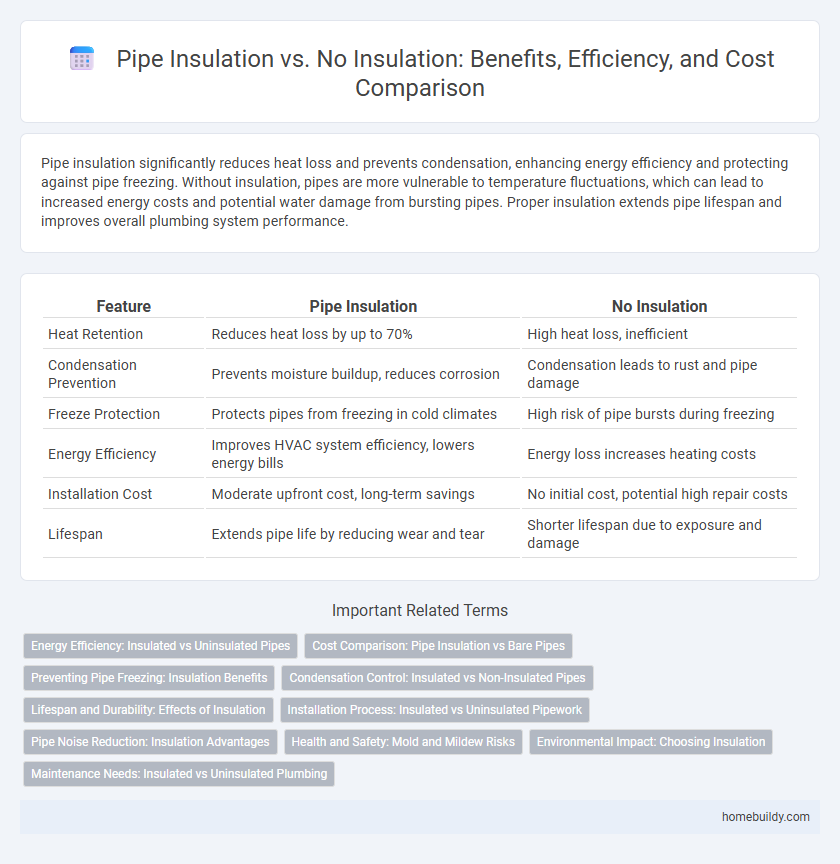Pipe insulation significantly reduces heat loss and prevents condensation, enhancing energy efficiency and protecting against pipe freezing. Without insulation, pipes are more vulnerable to temperature fluctuations, which can lead to increased energy costs and potential water damage from bursting pipes. Proper insulation extends pipe lifespan and improves overall plumbing system performance.
Table of Comparison
| Feature | Pipe Insulation | No Insulation |
|---|---|---|
| Heat Retention | Reduces heat loss by up to 70% | High heat loss, inefficient |
| Condensation Prevention | Prevents moisture buildup, reduces corrosion | Condensation leads to rust and pipe damage |
| Freeze Protection | Protects pipes from freezing in cold climates | High risk of pipe bursts during freezing |
| Energy Efficiency | Improves HVAC system efficiency, lowers energy bills | Energy loss increases heating costs |
| Installation Cost | Moderate upfront cost, long-term savings | No initial cost, potential high repair costs |
| Lifespan | Extends pipe life by reducing wear and tear | Shorter lifespan due to exposure and damage |
Energy Efficiency: Insulated vs Uninsulated Pipes
Insulated plumbing pipes reduce heat loss, maintaining water temperature and lowering energy consumption for heating systems by up to 30%. Uninsulated pipes experience significant thermal loss, leading to higher energy bills and decreased system efficiency. Energy-efficient insulation materials such as foam or fiberglass improve overall home energy performance and prevent pipe freezing during cold weather.
Cost Comparison: Pipe Insulation vs Bare Pipes
Pipe insulation reduces heat loss, leading to lower energy bills despite its upfront installation costs averaging $0.50 to $2.00 per linear foot, whereas bare pipes incur no initial expense but result in higher energy consumption. Long-term savings from insulation often outweigh the initial investment by decreasing heating or cooling load requirements and preventing pipe freezing damage. Maintenance and repair costs for insulated pipes are generally lower, enhancing overall cost efficiency compared to bare pipes.
Preventing Pipe Freezing: Insulation Benefits
Pipe insulation significantly reduces the risk of freezing by maintaining the internal temperature of plumbing pipes above the freezing point, especially in cold climates or during winter months. Insulated pipes minimize heat loss and prevent water from freezing, which can cause pipes to burst and lead to costly repairs. Using foam or fiberglass insulation materials around water pipes ensures energy efficiency and protects against cold weather damage.
Condensation Control: Insulated vs Non-Insulated Pipes
Insulated plumbing pipes significantly reduce condensation by maintaining surface temperature above the dew point, preventing moisture buildup and mold growth. Non-insulated pipes are prone to condensation, leading to water damage, corrosion, and decreased pipe lifespan. Proper pipe insulation enhances system efficiency and safeguards structural integrity by minimizing moisture-related issues.
Lifespan and Durability: Effects of Insulation
Pipe insulation significantly extends the lifespan and durability of plumbing pipes by protecting them from extreme temperature fluctuations and moisture exposure, which can lead to corrosion and cracking. Insulated pipes maintain stable temperatures, reducing thermal stress and preventing freezing damage during cold weather. Without insulation, pipes are more susceptible to wear and tear, resulting in frequent repairs and premature failure.
Installation Process: Insulated vs Uninsulated Pipework
Pipe insulation installation involves wrapping pipes with foam or fiberglass materials that require precise measurement and secure fittings to prevent heat loss and condensation. Uninsulated pipework simplifies installation by eliminating these steps, yet increases the risk of heat loss, freezing, and potential pipe damage in colder environments. Proper insulation significantly enhances energy efficiency and prolongs pipe lifespan, especially in plumbing systems exposed to temperature fluctuations.
Pipe Noise Reduction: Insulation Advantages
Pipe insulation significantly reduces noise caused by water flow and pipe vibrations, enhancing acoustic comfort in residential and commercial buildings. Insulated pipes minimize the transmission of sounds through walls and floors, effectively dampening rattling, hammering, and dripping noises. Uninsulated pipes amplify these disturbances, leading to increased sound pollution and potential disturbance in occupied spaces.
Health and Safety: Mold and Mildew Risks
Pipe insulation significantly reduces the risk of mold and mildew growth by preventing condensation on cold water pipes, which creates a damp environment favorable to these harmful fungi. Without insulation, excess moisture can accumulate, leading to structural damage and potential health hazards such as respiratory issues and allergies caused by mold spores. Properly insulated plumbing pipes maintain dryness and air quality, enhancing overall health and safety in buildings.
Environmental Impact: Choosing Insulation
Pipe insulation significantly reduces heat loss, decreasing energy consumption and lowering greenhouse gas emissions associated with heating systems. Without insulation, pipes can cause unnecessary energy waste, increasing carbon footprint and contributing to environmental degradation. Opting for high-quality, eco-friendly insulation materials supports sustainable energy use and minimizes overall environmental impact.
Maintenance Needs: Insulated vs Uninsulated Plumbing
Insulated plumbing pipes require less frequent maintenance by preventing condensation, reducing corrosion risks, and minimizing heat loss, which extends pipe lifespan. Uninsulated pipes are more prone to freezing, corrosion, and water damage, leading to higher maintenance costs and repair frequency. Effective pipe insulation enhances energy efficiency and reduces system wear, resulting in long-term savings on plumbing upkeep.
Pipe Insulation vs No Insulation Infographic

 homebuildy.com
homebuildy.com